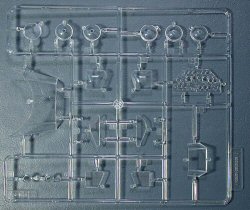
Trumpeter 1/35 Mi-4 Hound Kit First Look
By Michael Benolkin
| Date of Review | June 2005 | Manufacturer | Trumpeter |
|---|---|---|---|
| Subject | Mi-4 Hound | Scale | 1/35 |
| Kit Number | 5101 | Primary Media | Styrene/Photo-Etch |
| Pros | Nice Detailing, Excellent Subject Possibilities | Cons | Ejector pin marks on cargo compartment walls, doors |
| Skill Level | Intermediate | MSRP (USD) | $129.95 |
First Look
 |
 |
 |
 |
 |
 |
 |
The Mil Design Bureau started development of a more advanced multi-role helicopter in response to the Sikorsky S-55 that was entering service with the US armed forces. The S-55 would receive the military designation H-19 Chickasaw. In the same year that the Mil Mi-4 entered service (1953), Sabena Airlines began the world's first international helicopter service with the S-55.
Unlike the S-55, the Mi-4 would remain in production into the late 1960s within the Warsaw Pact and perhaps beyond that in China. While few (if any) S-55s remain operational today, you'll still find the rugged Mi-4 still in service with smaller military and civilian operators.
The Mi-4 is powered by a 1,700 horsepower Shvetsov ASh-82V radial engine and can accommodate up to 14 fully equipped troops or even a GAZ-69 command vehicle through its clamshell cargo doors under the tail. Variations of the Mi-4 also entered service in the anti-submarine warfare (ASW) and electronic warfare roles.
When I learned of the planned series of 1/35 scale Mil aircraft, the Mi-4, Mi-8/17 and Mi-24, needless to say I was excited. Until now, the Mi-4 Hound has been limited to 1/72 scale; the Mi-8/17 Hip was also limited to 1/72 (though a few limited-run kits did appear in 1/48). Only the Mi-24 Hind would enter the world in strength with outstanding kits in 1/72 by Hasegawa and in 1/48 by Monogram.
When I saw the test shots of the Mi-4 during the RCHTA Show a few years ago, the fit looked good and the detail was very nice - especially with that radial engine in the nose. In 1/35 scale, the size alone is impressive, but with positionable engine bay doors and cargo clamshell doors, the possibilities with this kit would be interesting to say the least.
The kit is molded in light gray styrene with no hint of flash and finely scribed panel lines. As you can see in the fuselage layout, this aircraft had many vents and openings around the nose to provide the necessary cooling air to that 1,700 horsepower engine. The kit captures the open framework look nicely and even provides photo-etched grilles for the air vents.
Another nice feature is the instrument panel. The panel is molded in clear styrene – just mask the instrument faces and paint and detail the surface of the panel. Next, remove the masks and place the instrument faces behind the panel and now you have a very realistic panel that will be visible through all of the top and side windows into the cockpit.
While the cockpit and engine compartments are fully detailed, the cargo compartment will need some attention should you opt to pose the rear clamshell doors open. There are quite a few ejector pin marks in and around the detailing molded on the insides of the cargo bay and on the clamshell doors. The good news is that should you decide to display the clamshell doors open, the cargo compartment is complete with floor and ceiling.
The transparent parts are molded crystal clear with just enough framing detail to make the job of masking easy. Optional parts are provided for flat or bulged cockpit side windows. Note the way Trumpeter is molding the tree runs onto the parts - they minimize damage to the part when clipped. While only a few manufacturers have caught on to this, it is evident that Trumpeter is raising the bar on injection molding technology.
The only other thing I could find wrong with the kit was actually on the decal sheet. The tail boom warning markings say ‘Danger’ (Opasno) and point to the rear. The decal printer somehow replaced the A in OPASNO with an English R – is this how you would pronounce OPRSNO with a Boston accent? At any rate, hopefully there will be some aftermarket decals released soon to offer up any of the thousands of Mi-4 colors and markings that have seen service since the mid-1950s.
If this kit builds as nice as it looks, I think it will be one of those kits that you simply place a bottle of glue in the box, close the lid, shake the box, and out will come a pristine model. We’ll see soon!
While I don’t know that I’d recommend this to be someone’s first model, I can’t see any construction problems. The only caution is to be sure there is sufficient weight in the nose so the model will not end up sitting on its tail. I recommend this kit to modelers of all skill levels.
My sincere thanks to Stevens International for this review sample!







